| (insert your NIE or newspaper logo here) |
Weekly Online LessonOnline Lesson ArchiveGrade Level: 8-12
|
Poland's Next Step
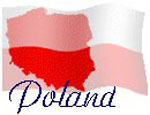 In
an effort to help the U.S. get a handle on peacekeeping efforts in Iraq,
the Republic of Poland formally took command of a sector of south-central
Iraq that's about one-third the size of Poland. The American government
invited Poland to run the security zone to reward its military support
for the war against Saddam Hussein's regime.
In
an effort to help the U.S. get a handle on peacekeeping efforts in Iraq,
the Republic of Poland formally took command of a sector of south-central
Iraq that's about one-third the size of Poland. The American government
invited Poland to run the security zone to reward its military support
for the war against Saddam Hussein's regime.
The transfer-of-command ceremony took place in the Iraqi city of Najaf on Wednesday, September 3, 2003. However, Polish forces won't actually be in command on the ground until about September 21, due to security concerns in the city after the recent car bombing of a mosque that killed a prominent Shiite Muslim cleric and more than 125 others.
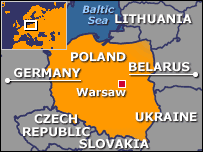 Poland,
with 2,400 troops in Iraq, is the largest non-U.S. troop contributor
in the region that it will command. The Polish military will lead a
total military force of 9,500, representing about two dozen nations.
Poland,
with 2,400 troops in Iraq, is the largest non-U.S. troop contributor
in the region that it will command. The Polish military will lead a
total military force of 9,500, representing about two dozen nations.
This commitment by Poland is a significant step in its country's growing role on the modern international stage. Poland has always had direct relationships with its Baltic neighbors. But just over the last decade, since achieving independence from the Soviet Union in 1989, the nation has been reconstructing its global identity.
Poland has seen a long and rich history of social and political change. Kings began ruling around the 9th century, and in the 15th century it became the first democracy in Europe. For centuries more, Poland was politically and socially squeezed by its neighbors, including Russia and Germany. Yet Poland's never-ending pursuit for stability and independence is continuous throughout Central Europe's turbulent history.
Polish ideals have also influenced American history. For example, in 1608 the first Poles arrived in the New World. They built and operated the first industry in North America — a glassmaking factory in Jamestown, Virginia. In 1619, the same Polish glassmakers staged the first civil rights strike in the history of America.
This week you're going to uncover the story of Poland, and learn how its past has sculpted the nation and its people.
The Early Years
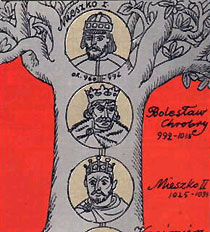 Polish
history began in the early 9th century when the Polians ("dwellers
in the field") obtained dominance over the other Slavic tribes
that occupied the country.
Polish
history began in the early 9th century when the Polians ("dwellers
in the field") obtained dominance over the other Slavic tribes
that occupied the country.
Begin your journey at the Polonia Today website, and journey back in time to when The Polish State Emerges.
Where did the name "Poland" originate? Who were the piasts? Who was the founder of the Polish state? How did Germany and Christianity influence the development of Poland?
Read further, about the Division into Provinces during the 12th century and the Crown of the Polish Kingdom in the 13th and 14th centuries.
How did other countries politically and socially affect Poland's people and their economy? In what ways did Poland's rulers promote or undermine the country's stability?
Next step into the 15th century and Poland's Union with Lithuania. How did this time period's events change the nature of the monarchy? How did the events influence the entire region, particularly with regard to religion?
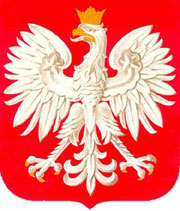 The
major cultural and social developments experienced during the 15th century
carried into the next 100 years, as you'll discover in the Republic
of the Gentry — the Golden Age and Culture
in the Golden Age.
The
major cultural and social developments experienced during the 15th century
carried into the next 100 years, as you'll discover in the Republic
of the Gentry — the Golden Age and Culture
in the Golden Age.
How did the "Polish Renaissance" come about? In what ways did this rapid and creative development affect the people and their society?
After the Golden Age came the End of Expansion. How were the Swedes able to invade Poland and what role did the Cossacks play in these events? How much were these events driven by religious motives?
Browse through the next couple of centuries and look at Poland's Attempts at Reform during the 18th century and the next century's Wars and Uprisings. What kinds of ties developed between Poland and Russia? What about Poland's relationship with France? In what ways did Polish society and the power and rules of the government change at the turn of the 20th century?
World War I and Beyond
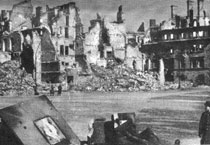 Keep
moving through the 20th century and witness Poland's Independence
Regained and the country's condition Between
World Wars.
Keep
moving through the 20th century and witness Poland's Independence
Regained and the country's condition Between
World Wars.
What kind of political, social and economic challenges faced the Kingdom and its people? How did the Soviet Union's Red Army gain entry into Polish territory? In what ways did culture get a boost?
World War II brought widespread devastation and suppression to Poland. How did the Soviets and Germans treat the Poles?
During The Post-War Years, 1945-1990, two major forces — communism and the Catholic Church — heavily influenced Polish life. How did Pope John Paul II affect the people? What was Solidarnosc and why was the movement important to modern-day Poland?
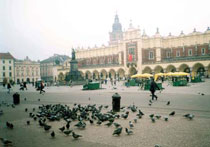 Your
time-traveling journey has ended, so now get on with some on-the-ground
traveling. Check out @Poland's Interactive
Map of cities. Just click on any of the city names —
like
Warszawa (Warsaw), Krakow,
Gdansk, or Poznan
— to learn more about each city and its history.
Your
time-traveling journey has ended, so now get on with some on-the-ground
traveling. Check out @Poland's Interactive
Map of cities. Just click on any of the city names —
like
Warszawa (Warsaw), Krakow,
Gdansk, or Poznan
— to learn more about each city and its history.
In what ways is Poland's history overall reflected in the history, architecture, and social and economic characteristics of each city?
Newspaper Activities
In Targetnewspaper, look for articles about Poland, Polish people, or Polish culture. Can you find stories about Poland's peacekeeping role in Iraq? If so, what are your reactions to how they are handling the ask of securing their zone and working with the Iraqi people and coalition forces? If the news is about another move by Poland to establish a stronger global presence, how are other nations responding to Polish identity and ideals? If you find stories about Polish people or culture, does the news or feature reflect the heritage within your own community or outside of your local area?
© Copyright 2003
Learners Online, Inc.
